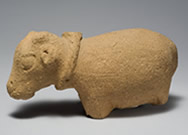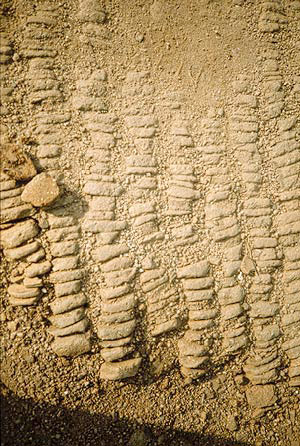The Art And Architecture Of Yorubaland! - Culture (6) - Nairaland
Nairaland Forum / Nairaland / General / Culture / The Art And Architecture Of Yorubaland! (128656 Views)
A Short History Of Yorubaland With Pictures / Art And Architecture Of The Igbo People / Benin Art And Architecture (2) (3) (4)
(1) (2) (3) (4) (5) (6) (7) (8) (9) (10) ... (16) (Reply) (Go Down)
| Re: The Art And Architecture Of Yorubaland! by lakal(m): 4:33am On Oct 04, 2011 |
Read more about how Frobenius knew where to dig -- he simply asked the people of Ife! http://books.google.com/books?id=z8Ef3NpQKyUC&pg=PA189&lpg=PA189&dq=ile+ife+bronzes+buried+rulers&source=bl&ots=Sc1AgRzd_E&sig=h66Ou5ulVr_-A-YsMkdC3DrSrKQ&hl=en&ei=SX6KTqL4FIT40gGQ19yDBQ&sa=X&oi=book_result&ct=result&resnum=3&ved=0CDIQ6AEwAg#v=onepage&q&f=false |
| Re: The Art And Architecture Of Yorubaland! by tpia5: 12:09am On Oct 05, 2011 |
interesting link. |
| Re: The Art And Architecture Of Yorubaland! by tpia5: 2:18am On Oct 05, 2011 |
Ok, i found out leo first learnt about ife art from the people of oyo katunga (the former capital of old oyo). He was very impressed by a miniature sculpture he saw at a market there, and when he asked where it was from, the traders told him ife, a town to the south. So he went to ife, made enquiries, and eventually found the artworks. No doubt he had assistance getting there, as well as escorts because i dont see how anyone could just waltz in and start digging up valuable artefacts. Oyo katunga was relocated to new oyo and the site of the original town in niger or kwara state is no doubt under kainji dam right now. Will check that later. |
| Re: The Art And Architecture Of Yorubaland! by lakal(m): 2:26am On Oct 05, 2011 |
^^ Katunga is in Oyo state. It is now known as Oyo-Ile. The former capital is surrounded by a national park -- Old Oyo National Park. |
| Re: The Art And Architecture Of Yorubaland! by tpia5: 2:32am On Oct 05, 2011 |
^Think i'm getting it mixed up with the capital which got destroyed during the fulani and the slaving wars. Thanks for the correction. i looked it up though and it seems oyo katunga was sacked by the nupe. |
| Re: The Art And Architecture Of Yorubaland! by amor4ce(m): 9:50am On Oct 05, 2011 |
. |
| Re: The Art And Architecture Of Yorubaland! by tpia5: 7:32pm On Oct 06, 2011 |
ooni obalufon 14th to early 15th century sculpture.  |
| Re: The Art And Architecture Of Yorubaland! by tpia5: 7:36pm On Oct 06, 2011 |
sculpture fragment circa 12th to 15th century  |
| Re: The Art And Architecture Of Yorubaland! by tpia5: 9:10pm On Oct 06, 2011 |
stone sculpture [undated]  |
| Re: The Art And Architecture Of Yorubaland! by tpia5: 9:16pm On Oct 06, 2011 |
12th - 15th century piece  |
| Re: The Art And Architecture Of Yorubaland! by tpia5: 9:25pm On Oct 06, 2011 |
  |
| Re: The Art And Architecture Of Yorubaland! by tpia5: 11:58pm On Oct 07, 2011 |
12th to 15th century potshed pavement  ooni and queen  |
| Re: The Art And Architecture Of Yorubaland! by lakal(m): 2:16am On Oct 10, 2011 |
More on the potsherd pavements posted by TPIA. Excavations have revealed extensive expanses of paved courtyards that were paved with potsherds during the "Classical" or "pavement" era of Ile-Ife (12th-16th Century). The periods before and after the potsherds are often known as the "pre-pavement" and "post-pavement" periods. Potsherd pavements have also been found at other Yoruba settlements. According to Prof. Akinwumi Ogundiran, "Most of the potsherd pavements in Yoruba region are composed of ceramic tiles laid on the edge in herringbone design in a prepared clay floor. These floor tiles are generally associated with temples/shrines, roads, and courtyard residences." Popular belief relates the potsherds to one of the few Female Ooni, Luwo Gbagida. Ooni Luwo's flowing robes were soiled by the mud of the streets of Ife, so (according to legend) she ordered the streets of Ife to be paved.  How the pavements were created, according to oral tradition: http://books.google.com/books?id=-U70Ts7CgEYC&pg=PA85&lpg=PA85&dq=luwo+ooni+pavement+ife&source=bl&ots=TG6YGYhXxw&sig=c2c6mmXPKy01-kmnO0xmVSJVfuU&hl=en&ei=IFaSTonjIu_HsQKNtqyeAQ&sa=X&oi=book_result&ct=result&resnum=1&ved=0CB4Q6AEwAA#v=onepage&q=luwo%20ooni%20pavement%20ife&f=false |
| Re: The Art And Architecture Of Yorubaland! by lakal(m): 2:55am On Oct 10, 2011 |
More of the ruins at Old Oyo (Katunga). 
|
| Re: The Art And Architecture Of Yorubaland! by lakal(m): 2:55am On Oct 10, 2011 |
 Round holes pierce the wall fragments in many locations. In most cases, these are two high for use as loopholes for those standing on the ground; so it is more probable that they were used for scaffolding during construction and, possibly, to support later parapets for those shooting over the wall. More research is needed to clarify this point. |
| Re: The Art And Architecture Of Yorubaland! by lakal(m): 2:59am On Oct 10, 2011 |
[img]http://images.nypl.org/index.php?id=1106720&t=r[/img] Entrance to the " Afin " or residence of the Alafin of Oyo, showing typical Yoruba thatching. (1911) |
| Re: The Art And Architecture Of Yorubaland! by lakal(m): 3:02am On Oct 10, 2011 |
[img]http://www.clarku.edu/~jborgatt/bg_shangoshrine1.jpg[/img] Shrine for Shango (defied King of Oyo, god of thunder). Ibadan, Nigeria. (1910) |
| Re: The Art And Architecture Of Yorubaland! by lakal(m): 3:05am On Oct 10, 2011 |
[img]http://t2.gstatic.com/images?q=tbn:ANd9GcQKJCWk29Q_ntsSFzXLf7KhixdqZu7Lg9pd9WEugoN9y9pszPpp[/img] Male figure, Yoruba peoples, Nigeria, Date unknown, Terracotta The Oshugbo or Ogboni society consists of the oldest and wisest men and women in a community. They settle disputes and balance the power of the king. This figure depicts a titled male elder. He wears the ritual sash over his left shoulder and the beads of office around his neck. His feathered and beaded headdress and seated pose may signify the special role of the king's representative. This is one of only two published terracotta Oshugbo figures; others are copper alloy. |
| Re: The Art And Architecture Of Yorubaland! by lakal(m): 3:14am On Oct 10, 2011 |
Yoruba ram heads. These ram-heads were placed on altars for worship in pre-colonial times as a form of ancestor worship. Ram heads were also associated with Shango/Jakuta worship. The first image dates to the 19th Century. (No date listed for the second).  [img]http://academics.smcvt.edu/africanart/Ruth/Images/Yoruba_Wood_Ram_Head.jpg[/img] |
| Re: The Art And Architecture Of Yorubaland! by tpia5: 3:38am On Oct 10, 2011 |
lakal: nice. i'm not familiar with this type of traditional thatching. the extremely few ones i know of, are just regular thatches covering small barns. this one is very impressive. Looks like waves. oh well, corrugated iron took over everything when it came out. the nigerian govt should really look into establishing a history village somewhere in nigeria like the ones in the US showcasing ancient ways of life. |
| Re: The Art And Architecture Of Yorubaland! by Booshman(m): 8:21am On Oct 10, 2011 |
tpia@: I've been saying this for years! Devote certain locations to recreate past villages like that of Oyo and Benin, with employees/tour guides dressed in the regalia of the past and even demonstrating how things were done. @Lakal There was that "Afin" photo from? It's a little tiny, and I would love to see a larger version of it to see the details. |
| Re: The Art And Architecture Of Yorubaland! by Amujale(m): 8:36am On Oct 10, 2011 |
Egbogi
|
| Re: The Art And Architecture Of Yorubaland! by Amujale(m): 4:06pm On Oct 10, 2011 |
This is what the Europeans & Arabs would happily have you forget! So they can claim it as their OWN like they are attempting with Kemet (commonly known as Egypt). How i thank our fore-fathers and fore-mothers for NOT giving up in the face of perscution and turmoil. If they had given-up like some of the north Africans did, i wonder what greater lies we would have been faced with today. Europeans & Arabs call us Idol worshipers, when they're the ones who that outfit best suits; one only needs study Roman, Greek and Arabian (not Arabic but Arabian) mythology to catch the drift. Africans have never worshiped so-called idols (its a foreign thing) and never will, we [b]celebrate [/b]our HEROES and rightfully so! [flash=250,250] https://www.youtube.com/watch?v=09w-ZFasRvE[/flash] [flash=250,250] https://www.youtube.com/watch?v=DaXRiEy15vY[/flash] [flash=250,250] https://www.youtube.com/watch?v=t9doHdsfhYg[/flash] |
| Re: The Art And Architecture Of Yorubaland! by Amujale(m): 5:16pm On Oct 10, 2011 |
lakal: True talk! Apart from Western Africa, Yoruba "settlements" can be found in places like Jamaica, Brazil, Cuba e.t.c |
| Re: The Art And Architecture Of Yorubaland! by lakal(m): 11:39pm On Oct 10, 2011 |
Booshman: Here is the link: http://digitalgallery.nypl.org/nypldigital/dgkeysearchdetail.cfm?trg=1&strucID=351083&imageID=1106720&parent_id=292496&word=&snum=&s=¬word=&d=&c=&f=&sScope=&sLevel=&sLabel=&total=35&num=12&imgs=12&pNum=&pos=13 |
| Re: The Art And Architecture Of Yorubaland! by Booshman(m): 11:46pm On Oct 10, 2011 |
lakal: Thank you! By the way, when I clicked on the picture, it enlarged it. Enough so you could see more details. |
| Re: The Art And Architecture Of Yorubaland! by tpia5: 10:30pm On Oct 11, 2011 |
| Re: The Art And Architecture Of Yorubaland! by tpia5: 10:35pm On Oct 11, 2011 |
| Re: The Art And Architecture Of Yorubaland! by tpia5: 10:55pm On Oct 11, 2011 |
kori stone [or quartz] from oyo  glass bead making went extinct in yorubaland sometime since the 19th or early 20th century. Richard Lander, the Cornish explorer, acquired something very much like this at Old Oyo in 1830, which was said to have come from "Iffie" (Ife) http://www.beadbabe.com/archives/html/yoruba_glass_beads_by_kwesi_am.html the consensus is that the Yoruba reworked imported glasses exclusively. Legend has it that these beads were first made by Olokun, a female deity and member of the Yoruba founding family. |
| Re: The Art And Architecture Of Yorubaland! by tpia5: 11:05pm On Oct 11, 2011 |
 It is apparent that there are two generations of Yoruba powder glass beads. The later group, for which evidence was found in Nigeria, is of coarser powder, showing little evidence of finishing. The earlier group, specimens of which Jamey Allen found in the British Museum, is much higher quality. In the above picture, the long yellow bead, the greenish one below it, the green and coral on either side of it, the pair of light blues, the fat blue to the lower left, and two or three of the navy blues are all part of this earlier group. These earlier powder glass beads, as were the beads in the British Museum, made of crushed old beads, not bottle glass. The difference in density is sensible to the touch, with the older beads noticeably heavier. Furthermore, the texture of the older models is much finer and they show evidence of lapidary finishing. segi beads from ife. date unknown.  The wealth of Ife was due to a bead making tradition. They exported their glass beads to the north of Africa and made this area very prosperous," she said. http://www.voanews.com/english/news/africa/Nigerian-Ife-Art-on-Display-in-Houston-106860644.html |
| Re: The Art And Architecture Of Yorubaland! by tpia5: 11:14pm On Oct 11, 2011 |
Yoruba - Blema Koli Glass. Date unknown. Strands of early mixed dichroic drawn glass beads from Nigeria  |
| Re: The Art And Architecture Of Yorubaland! by tpia5: 11:18pm On Oct 11, 2011 |
powder glass beads  date unknown. |
(1) (2) (3) (4) (5) (6) (7) (8) (9) (10) ... (16) (Reply)
Traditional Eastern Ijaw Attire In Pictures / The True Extent Of Alaigbo (Igboland) / 18+ Unclad Photos Of African Women Slaves From The Past.
(Go Up)
| Sections: politics (1) business autos (1) jobs (1) career education (1) romance computers phones travel sports fashion health religion celebs tv-movies music-radio literature webmasters programming techmarket Links: (1) (2) (3) (4) (5) (6) (7) (8) (9) (10) Nairaland - Copyright © 2005 - 2024 Oluwaseun Osewa. All rights reserved. See How To Advertise. 49 |


